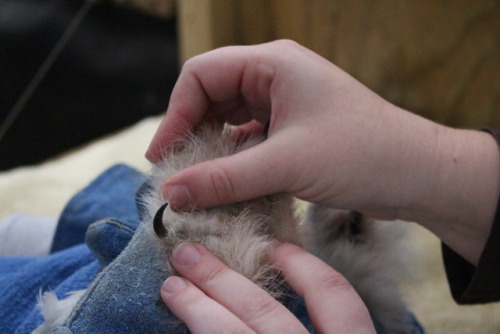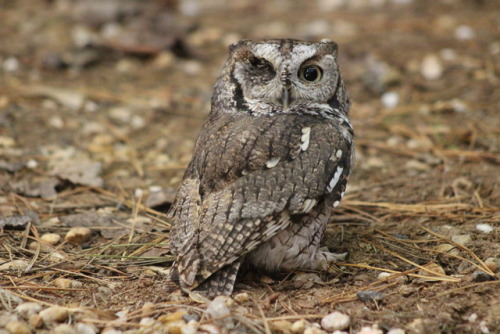#carolinaraptorcenter
Snowy Owl #21191 is doing great in his flight cage!
FAQ:
Is the Snowy Owl a male or a female? : He’s a male! You can tell by the light spotting on his secondary feathers, the large white “bib”, and the thin barring on his tail. Males tend to have more white than females. His weight is also in the range for males. We will be measuring his wings the next time he is handled for further confirmation.
How old is he? : He was born last spring, so as of January 1, he is now considered in his “second year”.
What are your plans to release him? Can I watch? : We plan on releasing him way up north. We’re still figuring out options for exactly WHERE we’ll be releasing him–we want to make sure we place him in the exact right place. Media coverage is still being considered. We expect him to be released in the next few weeks.
Why the delay in releasing him?: We’re still exercising him–that is, getting him to fly back and forth, as seen in the video. He’s doing great and exercising himself so far, and his flight is beautiful. We are also still working on finding the perfect release location!
Can I come see him?: No. We want to keep him wild and not get him used to people. Not even our staff members and volunteers can see him unless they’re actually taking care of him. The goal is always release, and we want him to go fly free!
It must be Snowy at CRC: Snowy Owl #2 is here!
Patient #21191 arrived on Thursday, December 14. He was seen by a pilot on a runway at the Piedmont International Airport. USFWS/APHIS has a protocol to capture and relocate birds at runways to prevent damage to the birds and to planes, so they captured him via a trap. Due to a moderately poor body condition and the fact that he had only been making short flights, they sent him to the Carolina Raptor Center.
He’s doing great with us. #21191 came in with a keel of 2/5, which is thin, but is MUCH better than the 1/5 keel score that our previous Snowy had. He was covered in feather lice, an external parasite. We followed our emaciation protocol and gave him fluids, vitamin B, iron, and we also started him on an antifungal, voriconazole. We ran bloodwork the next day, and it looked great.
On Sunday, we moved him into a large flight cage. He had a mini-health check to ensure everything was in working order (he looked fabulous, minus a little blood from his breakfast on his toes). He flew beautifully in the big flight cage and has been flying great since then.
So far, so good! He’s a beautiful bird!
You can track his progress here: http://raptormed.carolinaraptorcenter.org/cgi-bin/RaptorMedCGI.exe?patient=21191-2017-0935&forceDisplay=true
PS: Thanks, Joe Amodeo for being our photographer during the mini-health check and move (the first three pictures).
Post link
((Note: We got a SECOND interesting patient this week–a blog entry on him will come soon!))
Lady, you aren’t from around here!
A Snowy Owl Irrupts at Carolina Raptor Center
When we posted an article from Audubon Magazine on our Facebook page about a possible Snowy Owl irruption in 2017, we had no idea that we would be telling this story just a few weeks later.
On Monday, December 4, 2017, Rehab Associate Lauren Allen took a call from a very excited wildlife officer in Anson County, NC. He had picked up a bird off the side of the road that he was pretty sure was a Snowy Owl. Transport Volunteer Clyde Kiser brought the bird to the Jim Arthur Raptor Medical Center and all he had to say when he got there was, “this is a BIG bird. A beautiful bird.”Senior Medical Coordinator Mathias Engelmann confirmed later that day that this was indeed the first Snowy Owl admitted to the hospital in over 40 years. Certainly a milestone. One that many of us will never forget.
When she was admitted, the staff found that she was severely emaciated: about a skinny as they get. Engelmann recorded a 1 out of 5 keel score. Her initial examination was done quickly to reduce stress; stress can easily kill a bird in her state. She was put on fluids to rehydrate her, vitamin B and iron to help her create new red blood cells and restore her energy, and given liquid calories. When animals are emaciated, immediately giving them solid food can actually cause their bodies to fail, so we always rehydrate them first. She was also started on a preventative anti-fungal, since emaciated birds are very susceptible to contracting aspergillosis, an airborne fungal disease affecting the air sacs of raptors and other birds. After receiving quick and thorough treatment from the team, the Snowy Owl was put away in a warm incubator for the evening.
The next morning, she was perched but still very weak, and her wings were drooping from her weakness—not a good sign. We completed her treatments for the morning quickly and quietly returned her to her incubator. At midday, we did a more thorough exam and discovered some green bruising on one wing, though no bones felt broken. She was still too weak for a radiograph. We also switched her to a medication that treats aspergillosis, since CRC’s Staff Veterinarian Dave Scott suspected that she might already have the disease.At the same time, we drew a small amount of blood. It turned out that she had a packed cell volume of 29%–normal is around 45-50%. More alarming was that her blood albumin was nearly zero. Dr. Scott told the team that she had a 0% chance of survival without a blood transfusion, or a mere 10% chance of survival with a blood transfusion.
We do not have any resident Snowy Owls at CRC. We consider it too warm for them here to live comfortably year-round. Instead, we drew blood from one of our resident display Great Horned Owls, Harmony. We were successfully able to complete our first ever cross-species blood transfusion. Since Snowy Owls (Bubo scandiacus) and Great Horned Owls (Bubo virginianus) share a genus, we had hope that this would work, and we treated the Snowy Owl with a medication to help prevent allergic reactions just in case.Thankfully, she did not have an allergic reaction. She actually seemed to regain a little strength, and she tweezer fed a few bites of food later that evening.
Unfortunately, things took a turn for the worse that night. We found her deceased on Wednesday morning.
The Jim Arthur Raptor Medical Center is a teaching hospital as well as a medical center. A group of vet students and their professor were visiting from NC State University and were able to complete a necropsy (autopsy) with an endoscope. We used this less invasive method to help preserve the cadaver for educational purposes—and it had the bonus of giving the students practice with an endoscope. Aspergillosis was confirmed: she had multiple lesions in her air sacs.
—–
More Information on Snowy Owls
Snowy Owls typically live way up north, in the Arctic tundra. They do migrate in the winter, though typically not all the way into North Carolina. Experts predicted an “irruption” of Snowy Owls this year throughout the United States, and our Snowy Owl was certainly one of those. This is not the first Snowy Owl to be seen in North Carolina, nor is it even the furthest south they’ve gone; sightings of them as far south as Florida have been reported in previous irruption years. Most of these birds are very hardy and do quite well despite the change in landscape. Some do not make the journey so well and find hunting more difficult in the unfamiliar environment of the south—such may have been the case with our Snowy Owl. It is also possible that whatever caused the bruising on her wing also damaged her ability to hunt, thereby causing her to become even weaker and more stressed, leading to her develop aspergillosis.
So why are Snowy Owls moving so far south for the winter? This is not a new phenomenon. Over 30 years ago, a Snowy Owl was seen in Columbia, SC on the day one of our staff members was born! In fact, a very large irruption was reported in the 1920s, and irruptions have been reported even before then, and as far south as Florida. Irruptions do not tend to correlate with a lack of food up north, but with an abundance of food up north. Lemmings, the Snowy Owl’s main prey source, have a population boom every four years or so. In response, the Snowy Owls lay many more eggs, leading to a population boom of their own. When this happens, we see small irruptions, with “mega” irruptions once or twice a century.
To follow this year’s irruption, click on this link.
Post link
Imagine finding your front window looking like this!
Red-tailed Hawk #21192 came in today after smashing this window. The lovely home owners actually have decals on their back windows, just not that one!
He has some damage to both eyes, as well as several lacerations on his feet and one wing from the broken glass, but we expect everything to resolve well. Hopefully he’ll stay away from windows in the future!
You can follow his progress here: http://raptormed.carolinaraptorcenter.org/cgi-bin/RaptorMedCGI.exe?patient=21192-2017-0936&forceDisplay=true
Post link
Identification photos have become a great way for the public to see our rehab birds. Our goal is to always help the birds; we don’t want to hurt them just to take a picture. I use several measures to ensure minimal impact on them. First off, I spend a maximum of 30 seconds per bird in a cage to get a picture. If I can’t get a decent shot in 30 seconds, I leave and will try again another day. When possible, I also use either a food hatch or slip the camera through the door so the bird sees the camera instead of me. This prevents the birds from getting overly stressed, which can help them to avoid injuring themselves. We also do not want the birds to become habituated, or too familiar with humans. Limiting time in the cage helps to prevent this.
Since I only have 30 seconds to get a perfect photo, I snap pictures constantly. I may have a dozen or more pictures of a single bird in hopes of getting one good shot.
If you’re tracking a specific bird and want me to sneak out and get a picture, just call the hospital and ask! Sometimes I get busy and don’t have time to get photos of all of the birds, but I can usually take the time to get a specific individual.
Post link

















